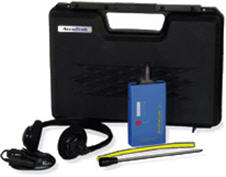I tell ya, this is a very handy piece of equipment. It makes finding a vacuum leak very quick. There are a multitude of other uses for it but my main use was to find vacuum leaks because these leaks in an EFI vehicle especially cause a lot of problems that my seem to be caused by other factors. Same as my ritual of performing a quick compression variation test, I also performed a quick vacuum leak test. It was as simple as waving the wand around under the bonnet. The device can hear a minute vacuum leak from metres away. When using the conventional stethoscope you have to pass the probe almost over the leak before you can hear it. In 10 seconds or less , I could eliminate vacuum problems from the diagnosis.
Here is a very good example of how good this tool is. The vehicle from memory was a VK Holden, EFI, black engine. The dealer brought the vehicle around wanting me to diagnose a running lean problem. I pulled out the Ultra sonic stethoscope and had a bit of a listen. This one was not so simple, I could hear a leak but it was not isolated to a single point where there would be a vacuum hose etc. The result was astounding. The problem was a porous intake manifold. This meant that some of the air the engine consumed was not passing through the air flow meter, consequently the meter signalled the ECU that the air flow was low and the ECU responded by injecting less fuel. Both I and the Holden mechanic used the conventional stethoscope and couldn't detect any vacuum leaks. I gave him the Ultra-sonic stethoscope so he could be satisfied that I came up with the correct diagnosis. The manifold was replaced and the problem was fixed. Now this example shows how superior this tool is.
How does it work, I just copied the following information from the manufacturers website: Ultrasound works by detecting the high frequency sound associated with friction, arcing and turbulence in industrial systems. These sounds are translated/converted down to the audible range where they can be heard in the headset and viewed on the meter. The meters are most sensitive to sounds around 40 kHz, that's twice the frequency of the best human hearing. Because its focus is on a specific band of sound, wind noise, industrial noises, voices, traffic, most operational sounds will NOT be detected. You can actually yell directly into the sensor and hear nothing. This exact frequency focus allows for precise leak detection.
This is the set I purchased for under $500 and it will be invaluable to me in the future for diagnostics. If you are a tradesman and interested in buying one and want more info type in ultra-sonic leak detectors into google. The business I purchased this one from no longer sells them. Better sets are worth much more and I highly recommend them over this cheaper unit as they are suited more for a working professional and have more features that come in handy.
